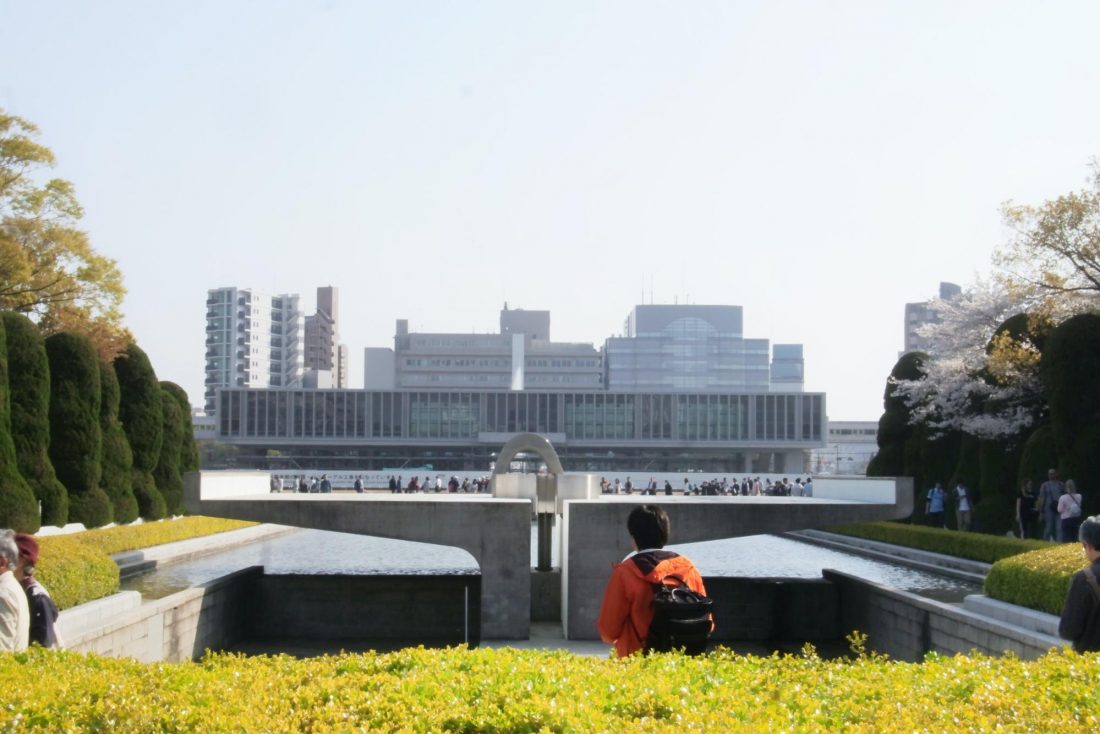100 Stories
10 Best Things to Do in Hiroshima
When I told my friends back home that I was moving to Hiroshima, many asked, “Is it totally safe to live there?” Though this may seem ignorant to some, it’s only after I moved here that I realized just how much of Hiroshima’s story—the resilience, the advocacy, and the hope and inspiration the city stands for—is overshadowed by the tragic event that took place on August 6, 1945.
Today, Hiroshima is a flourishing and peaceful city overlooking the beautiful Seto Inland Sea. It is an economic and cultural hub of the Chugoku area and home to 1.2 million residents. Even after living here for more than a year, I still feel that there is still so much to explore. Here are the 10 of the best experiences I have had in Hiroshima so far:
Overview
- 01. Visit Hiroshima Peace Memorial Park
- 02. Visit Hiroshima Castle
- 03. Go on a Gallery Hopping Tour
- 04. Enjoy Some Greenery
- 05. See a Hiroshima Carp Match
- 06. Try “Hiroshima’s soul food”
- 07. Try the Only Pizza Vending Machine in Japan
- 08. Night Out in Nagarekawa
- 09. Stroll Around Hondori
- 10. Take a Day Trip to Miyajima Island
Visit Hiroshima Peace Memorial Park

Photo by Vladimir Haltakov on Unsplash
This tranquil green park at the heart of Hiroshima used to be the city’s bustling commercial center until it was devastated by the atomic bomb. After the tragedy, the people of Hiroshima decided to build a memorial there rather than rebuilding the business district. Today, thousands and thousands of people from across the world visit the park, which is home to The A-Bomb Dome, Hiroshima National Peace Memorial Hall, Hiroshima Peace Memorial Museum, and many other monuments in memory of the bomb’s 140,000 victims.
The A-Bomb Dome, originally the Hiroshima Prefectural Industrial Promotion Hall, is the first memorial you’d come across if arriving from Hiroshima Station. It is one of the very few structures that remained in the wake of devastation and stands as a haunting reminder—it’s also a UNESCO World Heritage Site.
A minute southeast of the A-Bomb Dome, you can find the Zero Ground Plaque, which marks the exact spot over which the atomic bomb exploded.
Descending the stairs of the Hiroshima National Peace Memorial Hall, you will find an immersive, 360-degree panoramic photo of Hiroshima just after the devastation. The Hiroshima Peace Memorial Museum takes you closer to a full understanding of the horror caused by nuclear weapons. Its exhibits include interactive panels about the history of nuclear weapons, remains of clothing children were wearing when the bomb exploded, and memoirs and artworks created by survivors.
Under an arch-shaped monument in the center of the park is The Cenotaph for the A-Bomb Victims, a registry for the names of around 300,000 victims. Nearby, you’ll find the Flame of Peace, which has been burning since 1964 and will not go out until not a single nuclear weapon remains on earth. You can also find the Children’s Peace Monument, a bronze statue of Sadako Sasaki on a 9 meters high pedestal. Sadako Sasaki was a young girl hit by the blast when she was two years old, and who became famous for folding one thousand paper cranes before she died at age ten. The statue stands in memory of all the children affected by the tragedy. Every year, people send millions of paper cranes here in the memory of those children.
Visit Hiroshima Castle

Photo by Nicolas Doherty on Unsplash
Hiroshima was just a small fishing village until 1588 when construction began on Hiroshima Castle, also known as the “Carp Castle”. The castle marked the beginning of Hiroshima’s journey to becoming the flourishing city it is today. The same can be said for many of the other castles found throughout Japan, so visiting those castles is always a great place to start for anyone who wants to get to know a city.
Besides the museum, whose exhibits illustrate a vivid picture of the area’s history, the castle offers a beautiful garden, a wide moat with colorful carps, and, from its upper levels, one of the finest views of Hiroshima.
Go on a Gallery Hopping Tour

Auguste Renoir - The Branch at Croissy, 1911 at the Hiroshima Museum of Art
While its cultural heritage is beautiful and rich in its own right, Japan has an impressive collection of Western art in its numerous museums and galleries. Hiroshima is no exception, and I was very pleasantly surprised to find what Hiroshima had to offer to an art enthusiast. Among dozens of galleries and museums, the best places to start are the Hiroshima Museum of Art, the Hiroshima Prefectural Art Museum, and the Hiroshima City Museum of Contemporary Art.
While all three of them take pride in their extensive collection of Western and Eastern artists, Hiroshima Prefectural Art Museum collection focuses more on artists who have a close connection to Hiroshima Prefecture. Also, the centuries-old Shukkei-en Garden right next to the museum is an outstanding feature. The Hiroshima Museum of Art’s collection includes masterpieces by artists such as Pierre-Auguste Renoir, Claude Monet, Edouard Manet, Vincent Van Gogh, Pablo Picasso, and many more. And last but not the least, Hiroshima City Museum of Contemporary Art is the first museum in Japan dedicated exclusively to contemporary art, and it’s a must-see.
Enjoy Some Greenery

Going out of town to enjoy some nature is always a good idea, of course. But there is always something especially breathtaking about meticulously landscaped gardens. Whether or not you visit the Hiroshima Prefectural Art Museum, you must visit the museum’s Shukkei-en Garden, which is a spot no one would want to miss. This 400 years old site is a perfect example of the traditional Japanese garden. It flowers in every season, so it’s beautiful all year round. Make sure to have a cup of tea while enjoying the scenery.
Another stunning spot for nature lovers in the city is the Hiroshima Botanical Garden. This botanical garden, located on top of a picturesque hill just 30 minutes away from the Hiroshima city center, cultivates about 234,000 plants of 11,400 different varieties in its numerous outdoor gardens and greenhouses. Besides being beautiful year-round, its observation deck offers another great view of the surrounding area.
See a Hiroshima Carp Match

Photo by redlegsfan21, licensed under CC BY-ND 2.0
Despite being no expert in Japanese baseball teams, I’m quite sure Hiroshima Carp has the best fans. You’ll just know it when you see their logo everywhere in Hiroshima. Therefore, the atmosphere of their home games at Mazda Zoom-Zoom Stadium is one thing you definitely won’t want to miss. The story of the city and its much-loved team is truly moving, so read up on the history of the team before going to a match! Oh, and don’t forget to visit a food stall called Koi Court on the third floor of the stadium, which offers special menus created by the team’s players themselves.
Try “Hiroshima’s soul food”

You could call okonomiyaki a very versatile “savory pancake.” “Okonomi” means “how you like” in Japanese, and the chef will cook the dish on a countertop grill right in front of you, sizzling up your appetite. There are two styles of okonomiyaki in Japan: the Osaka style and the Hiroshima style. Which one is better has been a hot debate amongst Japanese people since… forever.
You didn’t do Hiroshima if you didn’t try their famous Okonomiyaki. There are many cities known for their mastery and pride for a certain dish, but I’m talking about an entire 4-floor building in the downtown area dedicated to restaurants specializing only in one dish. How many of those have you seen? The building, called Okonomimura, houses nearly 30 okonomiyaki restaurants. It is conveniently located around the eastern end of Hondori street. So go there, and you can add your two cents to the great okonomiyaki debate!
Try the Only Pizza Vending Machine in Japan
If you want to add a fun little “only-in-Hiroshima” feature to your trip, head to Fukuromachi Park, which is only a 5-minute walk from both Nagarekawa and Hondori. It might look like there’s nothing so special about this unassuming little park, but you’ll find the one and only pizza vending machine in Japan there! The vending machine is tucked in just across the street to the South, and it offers perfectly decent fresh-out-of-the-oven pizza ‘round the clock.
Night Out in Nagarekawa
Nagarekawa is a labyrinth of neon-lit streets filled with hundreds and hundreds of bars, clubs, and restaurants. It may not be the biggest nightlife district in Japan, but you’d still need a bit of expert advice to navigate the area. I’d recommend the Mac Bar, Koba, or Tropical Revoluсión. These are all small, cozy spots with friendly, English-speaking owner-bartenders and an awesome crowd. Go to one of these spots, get a drink, receive the wisdom of the bartenders (who are the experts in the area), make some friends (which is surprisingly easy), and start your adventure into the Hiroshima night.
Stroll Around Hondori

Photo by そらみみ, licensed under CC BY-ND 2.0
Hondori means “the main street” in Japanese, and this half-kilometer-long shopping arcade is indeed the main spot for downtown Hiroshima. Souvenirs, vintage clothing, electronics, cool designer brands, some of the best okonomiyaki or coffee in town—it seems like there’s almost nothing you can’t find in and around Hondori. Definitely worth a visit when you’re in Hiroshima.
Take a Day Trip to Miyajima Island

Photo by Bing Hui Yau on Unsplash
Well, this one is not exactly in Hiroshima city, but I just couldn’t leave it out. This is a UNESCO World Heritage Site and considered one of the most beautiful scenic views in Japan, after all. The small island, less than an hour away from Hiroshima, is famous for its Itsukushima shrine and its giant torii gate, both built on water. So, when you visit Hiroshima, put aside a day to spend on this tranquil little island. You can stroll its streets alongside the wild deer that live on the island, try their famous grilled oysters, and enjoy hiking in the beautiful scenery.

Photo by Juliana Barquero on Unsplash





